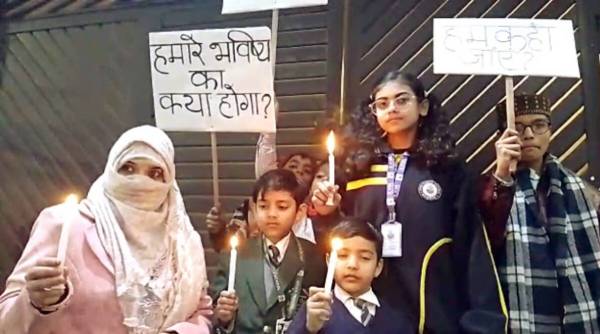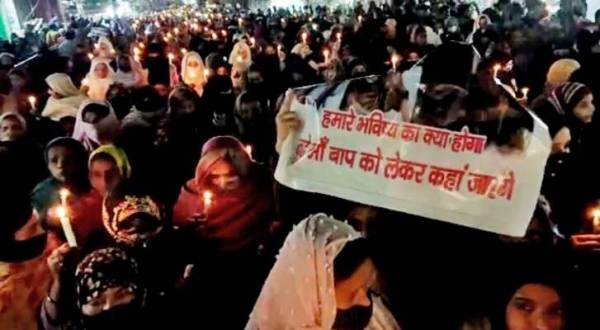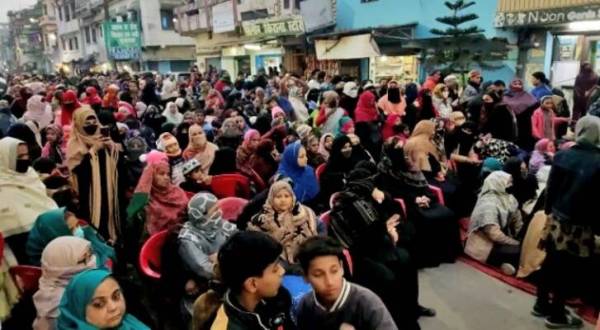Haldwani case: How did the Uttarakhand High Court arrive at its ruling?
On December 20 last year, the Uttarakhand High Court directed the Railways to evict those living in Haldwani’s Gafoor Basti, land adjoining the Haldwani railway station.
 People rejoicing the Supreme Court's verdict staying the order of the Uttarakhand HC evicting people living on land claimed by the railways in Haldwani. (Express)
People rejoicing the Supreme Court's verdict staying the order of the Uttarakhand HC evicting people living on land claimed by the railways in Haldwani. (Express) The Supreme Court Thursday stayed the Uttarakhand High Court decision to evict over 4,000 families from land claimed by the Railways in Haldwani, saying they could not be moved within a week and without rehabilitation plans. What was the earlier Uttarakhand HC order and how did it arrive at it?
What was the HC decision?
On December 20 last year, the Uttarakhand High Court directed the Railways to evict those living in Haldwani’s Gafoor Basti, land adjoining the Haldwani railway station. The decision by Justices Sharad Kumar Sharma and Justice Ramesh Chandra Khulbe came in a public interest litigation (PIL) filed in 2013. The petitioner had moved court against illegal mining in the area after a bridge collapse, but the HC expanded the scope of the petition.
 Protest in Haldwani on Wednesday. (ANI)
Protest in Haldwani on Wednesday. (ANI)
While the residents claimed ownership of the land through lease and sale deeds, the HC declared that the land belongs to the Railways and directed “to use the forces to any extent determining upon need, to evict forthwith the unauthorised occupants after giving them a week’s time to vacate the premises…”
What is the land dispute?
The land dispute essentially revolves around a 1907 government record, based on which Gafoor Basti residents claim ownership. The document, they claim, declared the area as “nazul land” or government land used for non-agricultural but public purposes. Some residents claimed in the HC that their ancestors had purchased plots from the Custodian Department of Government of India, which was entrusted with properties of those who left India after partition.
 Residents of Banbhulpura hold a candle march for their demands following the order of the Uttarakhand High Court on removing the encroachment near Haldwani railway station, on Monday. (ANI Photo)
Residents of Banbhulpura hold a candle march for their demands following the order of the Uttarakhand High Court on removing the encroachment near Haldwani railway station, on Monday. (ANI Photo)
However, the High Court held that the 1907 document was a mere ‘Office Memorandum’ and therefore invalid for the purposes of determining the classification of land. This would essentially mean that every transaction, sale, lease that flows from the document is now deemed invalid.
The court instead relied on a 1959 notification of the vesting of land with the Railways.
The Court had first ordered Railways to remove encroachment in the area in 2016. The state had sought a review of that ruling, but that was dismissed in 2017. Subsequently, the Supreme Court, hearing an appeal against the HC decisions, directed affected parties to file their objections before the High Court immediately.
 Dismissing the claim by residents that the 1907 record established the area as nazul land, the HC said the document is only “an official communication, it will not have a statutory force”.
Dismissing the claim by residents that the 1907 record established the area as nazul land, the HC said the document is only “an official communication, it will not have a statutory force”.
What is the claim by the residents?
Several affected residents have claimed that they have been in possession of the land for over 50 years. However, the Court said that “merely being in uninterrupted possession for last 50 years will not in itself mature their legal rights to continue with possession” since the 1907 document itself does not classify the land as nazul land.
Another resident moved the court claiming that “his grandmother Smt. Abida, was a purchaser from one Mr. Sardar Hukam Singh, by virtue of the sale deed dated 3rd May, 1960. The devolvement of right to the predecessors seller of his grandmother was flowing from the right given to Sardar Harnam Singh by the Custodian Department of Government of India, through a sale deed dated 12th December, 1959.”
 The residents, some of whom have been living there for decades, have been protesting against the court order. (Source: Twitter/@ShayarImran)
The residents, some of whom have been living there for decades, have been protesting against the court order. (Source: Twitter/@ShayarImran)
The HC dismissed this claim stating that the inclusion of a name in municipal records does not “confer a right.”
Another resident, Rehmat Khan, argued that the assessment committee of the municipality through its Resolution No. 18 dated April 18, 1976 had accepted the transfer of the land, made in his favour by the sale deed in 1966. The Court dismissed this argument expressing doubts on the sale deed itself.
On giving the residents a fair hearing, the High Court said that apart from “advertisements in newspapers inviting objections to the proceedings,” the news articles on the proceedings themselves will be treated as adequate notice.
 Over 4,000 families have been served eviction notices and given seven days to vacate the area, following an order to that effect issued by the Uttarakhand High Court. (Source: Twitter/@ShayarImran)
Over 4,000 families have been served eviction notices and given seven days to vacate the area, following an order to that effect issued by the Uttarakhand High Court. (Source: Twitter/@ShayarImran)
How did the HC decide in favour of Railways?
The HC records that “a railway line was laid down by a Company in the year 1884, and it was later on transferred to Government of India in 1943.”
“This fact has already been dealt by this Court, that in view of the notification of vesting of land with the Railways, as issued way back in 1959, it has also been a case of one of the interveners, that the railway lines in Haldwani stood established as back as on 1834, and at point of time, it was being operated by a private Railway Agency, and it was later on subsequently to the enforcement of the Railways Act, the management, control and establishment of the Railways of the North Eastern Region was vested with the Government of India,” the court stated.
 Hundreds of people, mostly women, have been turning up after the afternoon namaz to protest in Haldwani, asking for the demolition process, scheduled for January 8, to be stopped. (ANI Photo)
Hundreds of people, mostly women, have been turning up after the afternoon namaz to protest in Haldwani, asking for the demolition process, scheduled for January 8, to be stopped. (ANI Photo)
During the proceedings, the Railways also submitted to the court a report stating that 4,365 occupants of the state and Railways land were found to be ‘unauthorised’ and eviction process was immediately required to be initiated against them.
- 01
- 02
- 03
- 04
- 05






































